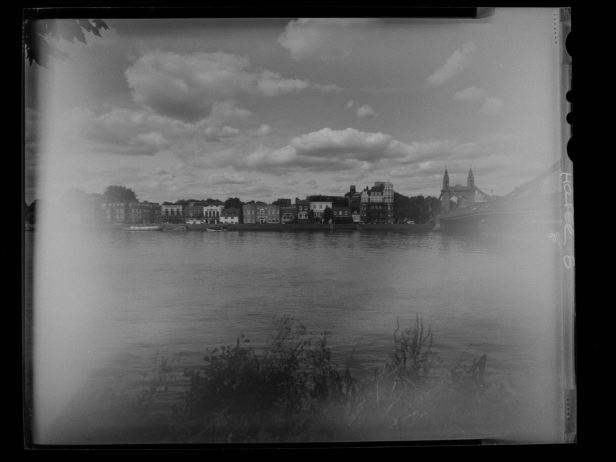Well, last Sunday I took my new camera out for a spin. Saturday night was spent loading film into the holders which overall was ok… but fiddly in my changing bag – so I think I will be purchasing a tent soon… just to give my hands room to move. I did do it with my eyes closed – a YouTube tip and I found that did actually make me focus more than when my eyes were open – if you’ll pardon the pun. As I found out later, two of the sheets were not correctly loaded and were spoiled in the process – at the time I did not think they were loaded right and I was proved correct. More about that below.
So I loaded 10 sheets from my pack of Ilford Delta ISO 100 black and white film into 5 double sided holders and then placed them in zip lock bags to prevent the holders from scratching up against each other – another YouTube video tip. Sunday afternoon which was hazy sunshine weather-wise turned out to be quite interesting for the pictures. I headed down to Hammersmith Bridge as I thought this would make for some more interesting compositions. Now all the videos I had seen and the articles I had read, said that large format photography slows your photographic process down. And they were right. Setting up the camera on the tripod, trying to get it level, opening it up, inserting the lens, deciding on composition, working out the focus, metering the light, setting the aperture and shutter speed, remembering to open the shutter to focus and then to release it before you put in the film holder, inserting the film holder, pulling out the dark slide, taking the picture and the reinserting the dark slide the opposite way around. It’s a whole new process that at times simply tested my patience because I could have fired off 30 shots with my digital in that time frame. But at the same time, it was liberating. I only had 10 sheets so could only take 10 pictures – in reality, that turned into 8 when two sheets from the same film holder crumpled when I tried to insert the dark slide back in.
Two apps which proved very useful were: Holders – it records what film holder (providing you catalogue them, film, ISO, aperture and speed, and GPS (when I remembered to use it) which you can export as your notes.
Update:
I’ve been waiting for Ilford to send me the scans of the negatives, but my ‘new found patience’ only lasts for so long. Therefore, I purchased a fairly inexpensive light table (which my niece can also use for drawing) just to take some quick and dirty pictures of the negatives which I inverted and processed quickly on Lightroom mobile. Yes, they processed the negatives and sent them back in a jiffy!
I was too lazy to get out my DSLR and work up a proper macro lens shot. So the results?… mixed but I am in no way disheartened. So apart from loading the film incorrectly in one of my holders, I suspect that another one either has a light leak or I did not load it correctly in the camera… I am inclined to believe the latter at this stage as it’s fogged at both ends of the picture. Despite the fogging, it appears in focus.

These are my favourites as the focusing is as sharp as I managed to get… I do need to work on that some more.
These were less successful. The focusing was off which you can see when you zoom in.
Once I get the scans from Ilford, I’ll post process and repost with a comparison. I have enjoyed using the 4×5 and despite the expense (in comparison to the DSLR), this is something I want to continue with. I’ll make many more mistakes and hope that I will learn from. The fact that I have had to slow down and in some way be more selective is strangely liberating.
On all of the negatives I have some scratches and possible dust so I need to work on loading and cleaning my holders better and always handling them with gloves once processed.
Before I go, the iPhone reference shot v the quick and dirty 4×5 edit – putting the iPhone post processing aside, I still think I will have much more to play with the 4×5 scan.









Love the expansive feel of these.
Will be interesting to see the directions we all take post course!…
LikeLiked by 1 person
Thanks. I’m looking forward to using it in Tuscany in September. Now trying to source filters for a 70mm diameter lens that is proving nigh on impossible… it seems they do not make this size anymore 😦
LikeLike
Oh that sounds good! You should get some great pics there.
Hmmm pain about the 70mm. Guess you have checked the Euro and US marketplaces too?
LikeLiked by 1 person
Yes am on it… it might just take a while
LikeLiked by 1 person
Zig came to the rescue as always – https://www.cokin-filters.com/filter-systems/creative/kits/#black—white and https://www.amazon.co.uk/gp/product/B00009R7LI/ref=oh_aui_detailpage_o01_s00?ie=UTF8&psc=1
LikeLiked by 1 person
Zig and my friend Eddie… !!!
LikeLiked by 1 person
Great stuff!!!! ❤️
LikeLiked by 1 person
Thank you 😊
LikeLike